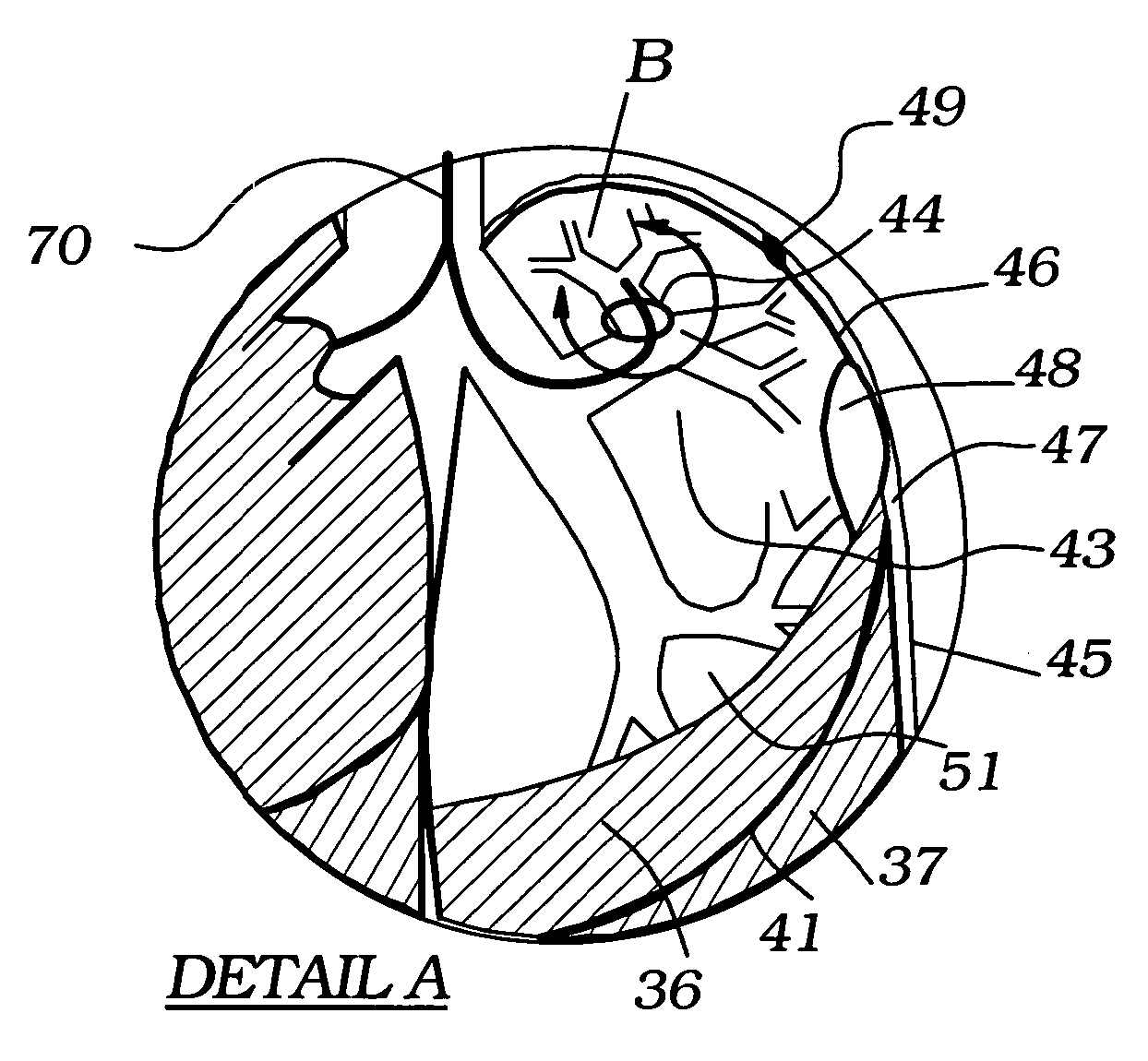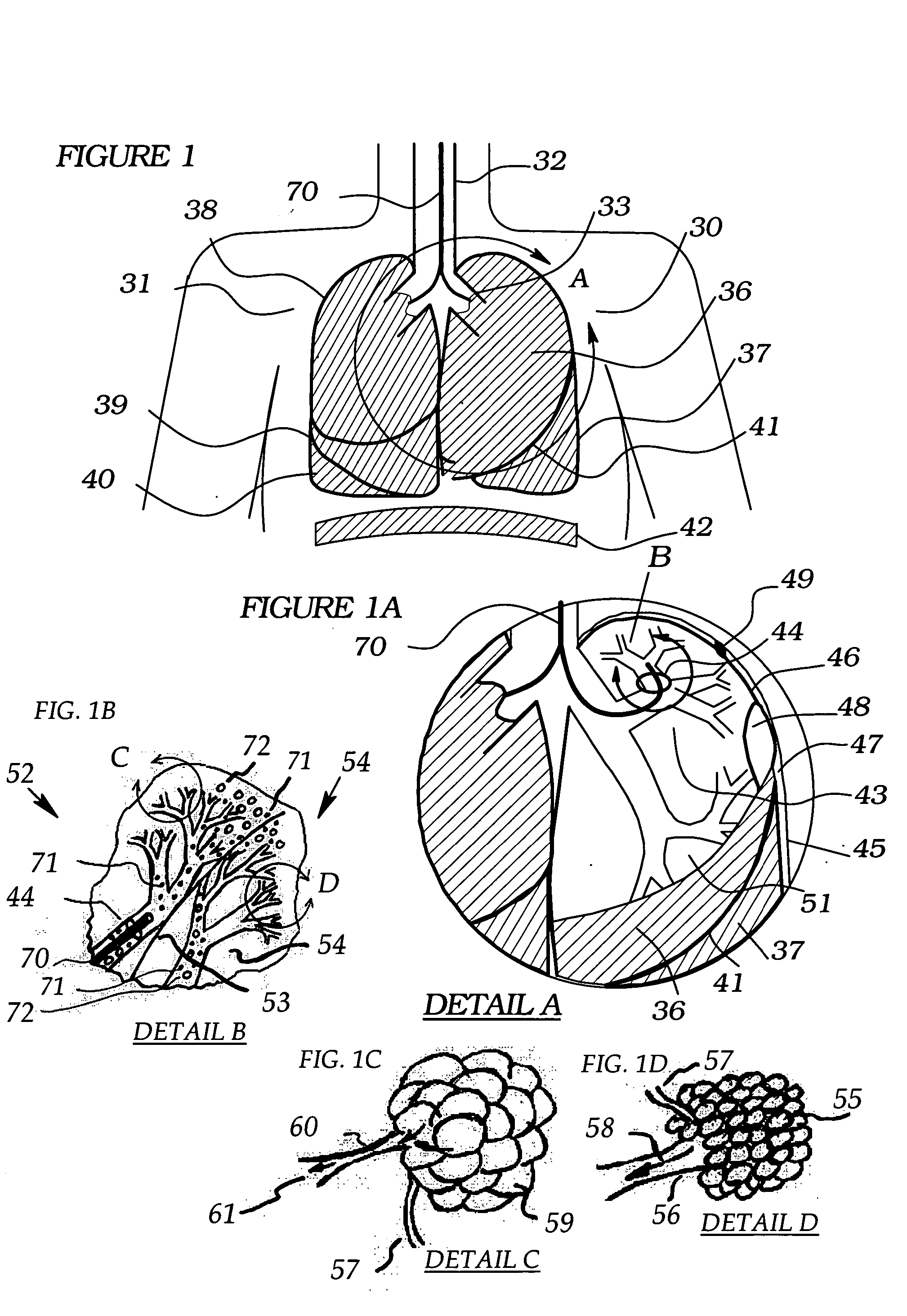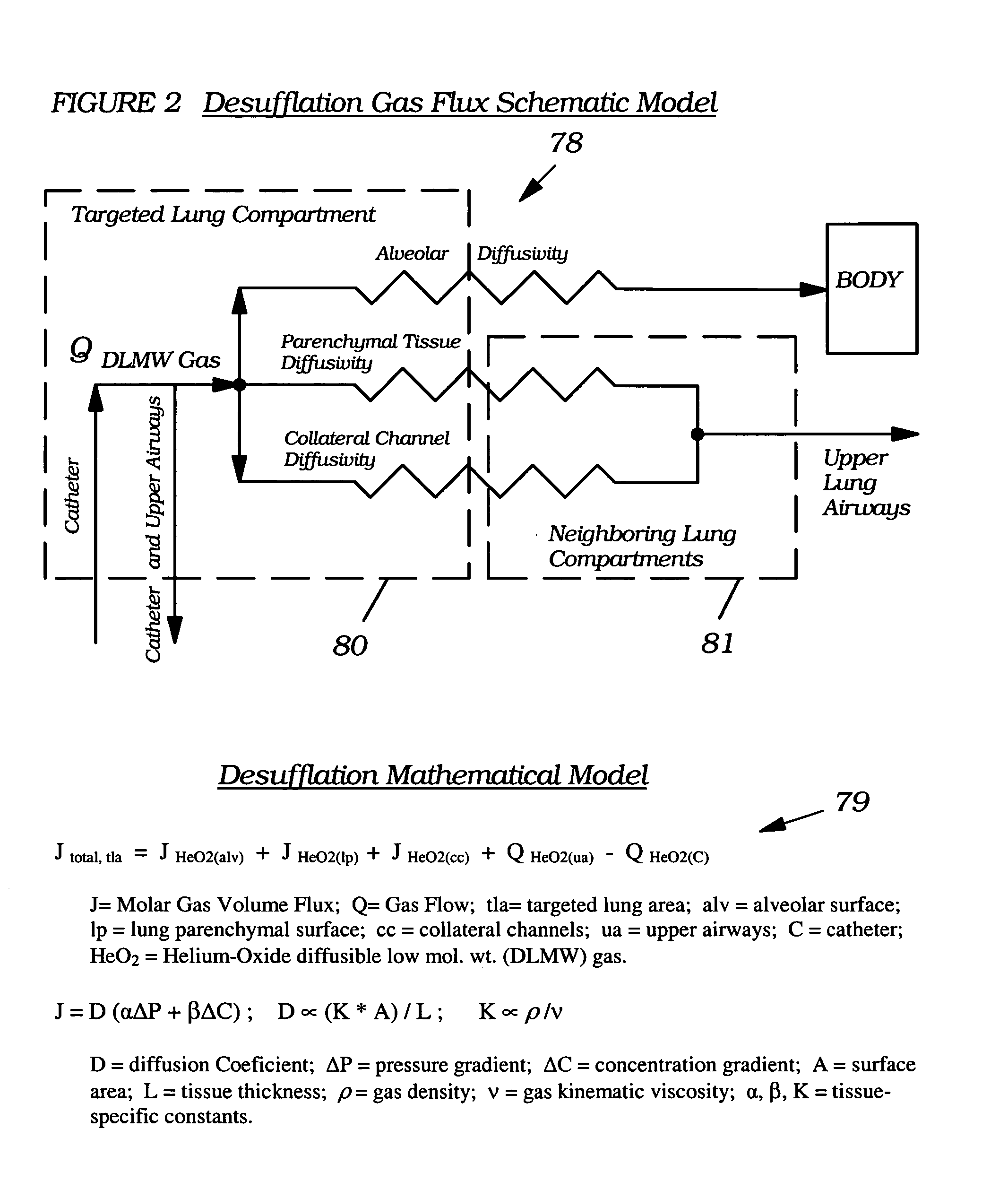The elasticity loss also causes small airways to become flaccid tending to collapse during
exhalation,
trapping large volumes of air in the now enlarged air pockets, thus reducing bulk air flow exchange and causing CO2 retention in the
trapped air.
Mechanically, because of the large amount of
trapped air in the
lung at the end of
exhalation, known as elevated
residual volume, the intercostal and diaphragmatic inspiratory muscles are forced into a pre-loaded condition, reducing their leverage at the onset of an inspiratory effort thus increasing work-of-
breathing and causing dyspnea.
These therapies all have certain disadvantages and limitations with regard to effectiveness because they do not address, treat or improve the debilitating elevated
residual volume in the lung.
Because these
modes do nothing to address, treat or improve the hyperinflated
residual volume of the
COPD or emphysema patient, and because
mechanical ventilation is performed on the lung as a whole and inherently can not target a specific lung area that might be more in need of treatment,
mechanical ventilation is an ineffective solutions.
This approach may slow the progression of the
disease by blocking continued
elastin destruction, but a successful treatment is many years away, if ever.
It may be possible to treat or even prevent emphysema using
biotechnology approaches such as
monoclonal antibodies,
stem cell therapy,
viral therapy,
cloning, or xenographs however, these approaches are in very early stages of research, and will take many years before their viability is even known.
Approximately 9000 people have undergone LVRS, however the results are not always favorable.
There is a high
complication rate of about 20%, patients don't always feel a benefit possibly due to the indiscriminate selection of tissue being resected, there is a high degree of surgical trauma, and it is difficult to predict which patients will feel a benefit.
Therefore LVRS is not a practical solution and inarguably some other approach is needed.
While this method may be less traumatic than LVRS it presents new problems.
First, it will be difficult to isolate a bronchopulmonary segment for suction into the sleeve.
Secondly the compliant sleeve will not be able to conform well enough to the contours of the chest wall therefore abrading the pleural lining as the lung moves during the
breathing, thus leading to other complications such as adhesions and pleural infections.
The main flaw with this method is that trapped gas will not effectively dissipate, even given weeks or months.
Rather, a substantial amount of trapped gas will remain in the blocked area and the area will be at heightened
infection risk due to
mucus build up and migration of
aerobic bacteria.
Another
disadvantage with this invention is
adhesive delivery difficulty; Controlling
adhesive flow along with gravitational effects make delivery awkward and inaccurate.
Further, if the
adhesive is too hard it will be a tissue irritant and if the adhesive is too soft it will likely lack durability and
adhesion strength.
Some inventors are trying to overcome these challenges by incorporating
biological response modifiers to promote tissue in-growth into the plug, however due to biological variability these systems will be unpredictable and will not reliably achieve the relatively
high adhesion strength required.
A further
disadvantage with an adhesive bronchial plug, assuming adequate adhesion, is removal difficulty, which is extremely important in the event of post
obstructive pneumonia unresponsive to
antibiotic therapy, which is likely to occur as previously described.
However, a flaw with this method is that the collagen will have a tendency to gradually return towards its initial state rendering the technique ineffective.
While technically sound, there are three fundamental physiological problems with this method.
First, the rapid mechanical retraction and collapse of the
lung tissue will cause excessive shear forces, especially in cases with pleural adhesions, likely leading to tearing, leaks and possibly hemorrhage.
Secondly, distal
air sacs remain engorged with CO2 hence occupy valuable space without contributing to
gas exchange.
Third, the method does not remove
trapped air in bullae.
Also, the anchors described in the invention are not easily removable and they will likely tear the diseased and fragile tissue.
Its inventors propose that this method may be effective in treating homogeneously diffuse emphysema by preventing
air trapping throughout the lung, however the method does not appear to be feasible because of the vast number of artificial channels that would need to be created to achieve effective communication with the vast number lobules
trapping gas.
Hence during
exhalation there is an inadequate pressure gradient to force gas proximally through the valve.
Secondly, small distal airways still collapse during exhalation, thus still trapping air.
Also, the area will be replenished with gas from neighboring areas through intersegmental channels, trapped residual CO2-rich gas will not completely absorb or dissipate over time and post-
obstructive pneumonia problems will occur as previously described.
Finally, a significant complication with a bronchial one-way valve is inevitable
mucus build up on the proximal surface of the valve rendering the valve mechanism faulty.
While apparently technically, physiologically and clinically sound, these methods still have some inherent and significant disadvantages.
First, aspiration of trapped air by negative pressure is extremely difficult and sometimes impossible because
mucus in the distal airways will instantly plug the airways when vacuum is applied because of the vacuum-induced
constriction of the fragile airways.
Also, it is difficult to avoid collapse of the distal airways when they are exposed to vacuum due to their diseased in-elastic state.
Therefore, aspiration of an
effective volume of trapped air using vacuum may be impractical to implement.
Secondly, a vacuum technique will not remove the excessively trapped air in bullae.
Third, the collapse-by-aspiration techniques described in these patents explain a relatively rapid deflation of the targeted area conducted while a clinician is attending to the instruments introduced into the lung, for example generally less than thirty minutes, which is the time a patient can tolerate the bronchoscopic procedure.
Collapse-by-aspiration in this short a time period will often produce traumatic tissue shearing between the collapsing and non-collapsing areas, leading to tearing, leaks and hemorrhage, especially if there are adhesions and bullae present.
Forth, although installation of low molecular weight gas may facilitate collapse by absorption, infusion of respiratory gases from neighboring lung areas through intersegmental collateral channels will refill the targeted lung area rending collapse incomplete.
Some additional disadvantages of this technique include post-
obstructive pneumonia, assuming incomplete air removal; the technique requires constant attendance of clinician which is impractical if a slow, gradual collapse of the lung area is desired; and finally the technique will be limited to large lung sections because suctioning requires a relatively large
catheter inner
diameter in order to avoid mucus plugging of the instruments.
To summarize, methods for minimally invasive
lung volume reduction are either ineffective in collapsing the hyperinflated lung areas, or do not remove air in bullae, or collapse tissue too rapidly causing shear-related injury, or cause post-obstructive pneumonia.
 Login to View More
Login to View More  Login to View More
Login to View More 


